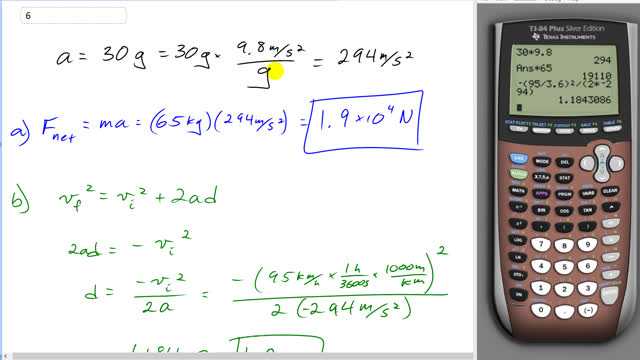
A person has a reasonable chance of surviving an automobile crash if the deceleration is no more than 30 g's. Calculate the force on a 65-kg person accelerating at this rate. What distance is traveled if brought to rest at this rate from 95 km/h?

In order to watch this solution you need to have a subscription.
This is Giancoli Answers with Mr. Dychko 30 g of acceleration has to be written in m/s squared. So, we'll multiply 30 g by 9.8 m/s squared for every g. And so the gs cancel and we're left with 294 m/s squared, and that's the acceleration that we multiplied by mass to get the net force on this person. And it's the net force because there will be only one force acting on the passenger or the driver when they're coming to the crash, and horizontally speaking, that'll be the force exerted by the car backwards. So, that's 139x10^4 Newtons. And to calculate the distance that the person will travel during the crash, we know that the final velocity is zero, and were given the initial velocity, 95 kilometers an hour, and we've calculated the acceleration. And we'll solve this for d. So, subtract V initial squared from both sides. And then we get the next line and we'll divide by 2a, both sides. And we get the displacement will be the negative of the velocity converted into m/s. This is the same as dividing by 3.6 which is what I did here but you can see the units all match up, the hours cancel and the kilometers cancel leaving us with m/s. And so, that's 95 kilometers an hour times 1 hour for every 3600 seconds times 1,000 meters for every kilometer. And square that result and divide by 2. And then this acceleration is negative because it's going to be in the opposite direction to the velocity which we've taken to be positive inside the brackets here. This negative is just from the algebra. And we end up with positive 1.2 meters displacement. So, positive just means it'll be in the direction of the initial velocity, of course. And so the driver will go 1.2 meters before coming to a stop.
Why you said that the velocity and acceleration is negative and velocity is positive that is always or just in this case.
Hi joseotilio25, there is no rule along the lines of "velocity is always positive" or "acceleration is always negative". Instead, you have to choose your coordinate system (it really is a choice you get to make, so you'll see different people making different choices). When you "choose your coordinate system", that's a fancy way of saying you have to choose which direction is positive. I chose the initial direction of motion of the car to be positive, and typically I choose to make the direction of initial velocity the positive direction, but it's not a "rule" to do so. Since the car is stopping, it's acceleration is in the opposite direction to the initial velocity. If the acceleration was in the same direction as the initial velocity, the car would be speeding up. However, the car is slowing down and quickly coming to a stop. This means the acceleration is in the opposite direction to the initial velocity. Since the initial velocity direction was chosen to be positive, this means the acceleration is in the negative direction.
Cheers,
Mr. Dychko